2018 Audi Q5 vs Lexus NX300h vs Volvo XC60 comparison
The new XC60 is impressive but is it better than the latest Q5? We’ve also got the Lexus NX300h to see if the petrol-hybrid could be the wild card in the pack.
Published on Mar 28, 2018 12:45:00 PM
68,137 Views
Follow us on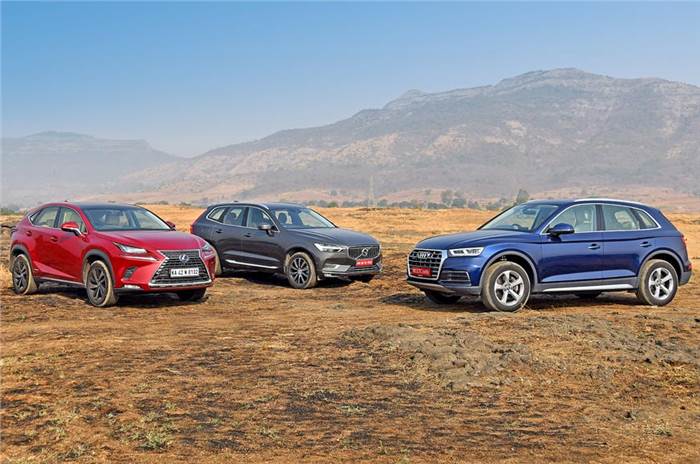
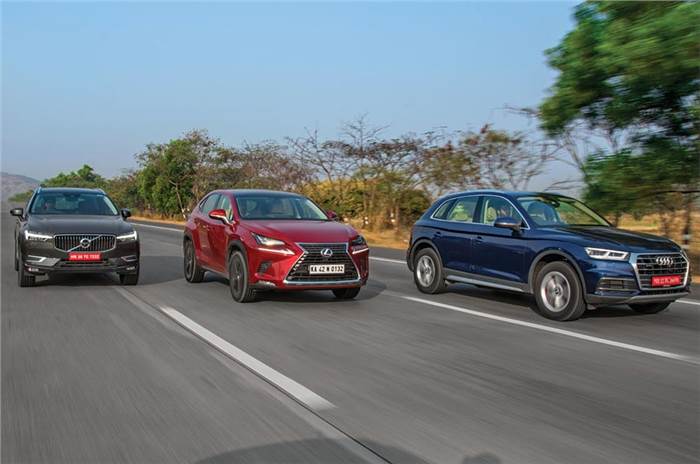
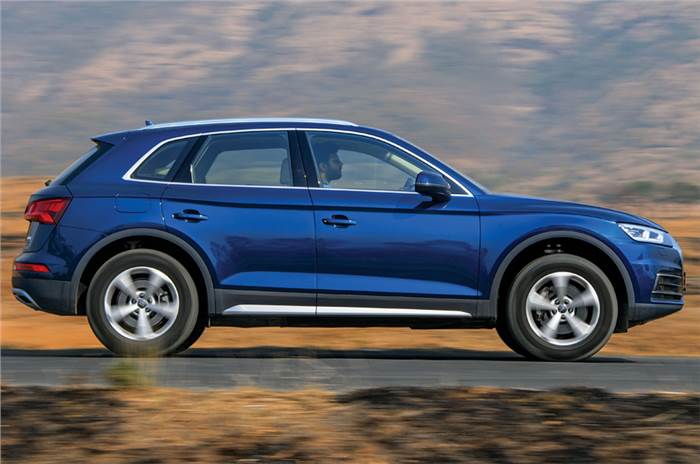
Bad roads are tackled extremely well in the Q5. Remains pliant at all times.
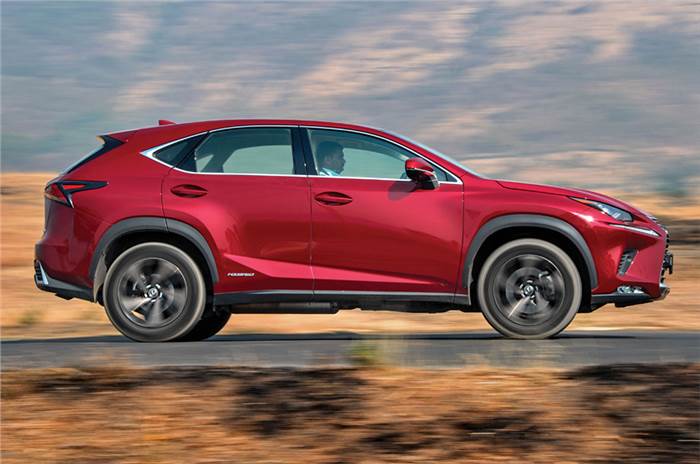
The Lexus' suspension thumps, thuds and sometimes crashes on bad roads.
Volvo has gone all-out with its latest XC60 and the result is for all to see. It’s a handsome SUV with a beautiful cabin, a huge list of standard features and a strong diesel engine. And it’s sensibly priced too. But soon after the Volvo’s arrival has come the new Audi Q5, that interestingly plays on similar strengths. It is attractive, if in an Audi-typical understated manner; it has a spacious cabin and it’s impressively fast too. While we’re interested to find out which of these two new diesel SUVs is the one to spend big bucks on, we’re also curious to know if a petrol hybrid SUV can cut it in this crowd. The SUV in question is the Lexus NX300h. It’s a well-equipped and refreshingly different looking SUV but what brings it into contention is that it’s aggressively priced and going by its 18.3kpl ARAI-tested fuel economy figure also promises running costs at par with its diesel rivals.
There’s only one thing to do, and that’s to spends some quality time with these SUVs.
What are they like inside?
Each of these three has a distinct flavour when it comes to the interiors. The Audi Q5’s cabin has an air of sophistication that is understated. Right from the time you shut the door, there’s a sense of solidity and the cabin feels very well-built. The lacquered wood trim running the breadth of the doors and dashboard does look very classy, and all the buttons and switches ooze quality. While all three cars have large panoramic roofs, it’s the Audi’s cabin that feels the brightest of the lot, and that’s mainly due to the clever beige and black theme. Even the doors open wider than the rest and getting in and out is very easy, even at the rear. The chauffeur-driven lot will be the most comfortable in the Q5’s back seat as it is very well supported, has nice cushioning and also comes with a lot more knee room compared to the other two. Its rear seat can recline and there are window sunshades for more comfort. A third passenger, though, will be least comfortable in the Q5 because of the massive hump in the floor for the transmission tunnel.
| Lexus NX Price, Mileage, Specifications, Features and Variants | |
|---|---|
| Brand | Lexus |
| Model Name | NX |
| Lexus NX Price | ₹ 77.94 - 85.90 lakh |
| Lexus NX Range/Mileage | NA |
| Lexus NX Specifications | SUV | 5 doors | 5 seats View All Specs |
| Lexus NX Features | LED headlight | 14-inch Touchscreen display | 8 airbags View All Features |
| Lexus NX Variants | 350h Hybrid Exquisite | 350h Hybrid Luxury | 350h Hybrid F-Sport View All Variants |
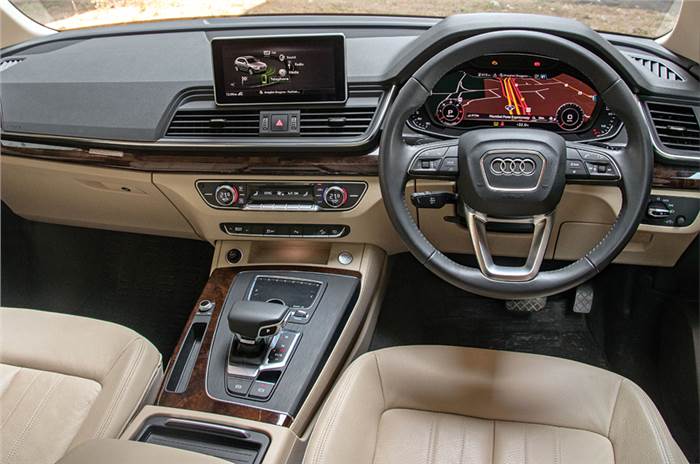
While the Q5 was understated, the Japanese NX300h is quite flashy. The dashboard is dominated by a spindle-like centre console housing a classy analogue clock. Despite being a bit edgier on the inside, the design isn’t over the top and the colours and materials used work very well. Quality of bits is good in general, but look closer and bits shared with lesser Toyotas drag down the level of sophistication and opulence. A thoughtful feature is that every time the car is switched off, the steering retracts and the seat slides back automatically for the driver to easily exit the vehicle. Getting into the back seat is also easy because of the low floor, however, because of the sloping roof, headroom is tight at the rear and the space in general is less than that of the competition. This car has electrically adjustable rear seats and they recline to a very comfortable angle. But these seats are also set low, making passengers sit in a knees-up position. Also, while the front seats are cooled and heated, the rear seats only get the heating function.

The Volvo’s interiors are very opulent and extremely high on quality. The large vertical infotainment screen, superbly detailed bits and large sections of wood add to the cabin’s aesthetic appeal. What really stand out are the front seats, which are draped in soft, high-quality Nappa leather. Not only are these seats extremely comfortable and supportive, but they get heating, cooling and, a segment-first, massage function. The rear seat experience, though, isn’t as great. Firstly, the doors don’t open too wide, so getting in and out isn’t as easy. Then, the lower back support is a bit too intrusive and the back rest is very upright. Passengers with large body frames will also dislike the narrow side bolstering.

How do they compare on features?
Each of these cars is well equipped. The Q5 gets kit like adaptive LED headlamps, electric tailgate operation, electric front seats with memory for the driver seat, rear view camera with front and rear sensors, and a host of safety features like eight airbags, ESP, ABS etc., all of which are also available in the other two.
Unique to the Lexus is a 14-speaker Mark Levinson sound system, electric reclining rear seats and an electric steering adjust. It gets kit like a 360-degree camera, head-up display, cooled and heated front seats and heated rear seats, all of which the XC60 also gets. However, the NX’s panoramic glass roof is fixed, unlike the others.
The XC60 is easily the best-equipped and boasts of an air-suspension, a segment-first massage function for the front seats, Nappa leather, 19-inch wheels and a host of radar-based features like blind spot assist, lane-keeping aid, autonomous braking, adaptive cruise control, etc. It also gets a TFT instrument cluster like the Audi’s virtual cockpit.
| Dimensions | |||
|---|---|---|---|
| Audi Q5 35TDI Technology | Lexus NX300h Luxury | Volvo XC60 Inscription | |
| Length | 4663mm | 4640mm | 4644mm |
| Width | 1893mm | 1845mm | 1902mm |
| Height | 1659mm | 1645mm | 1658mm |
| Wheelbase | 2819mm | 2660mm | 2865mm |
| Boot space | 550 litres | 475 litres | 505 litres |
| Fuel tank capacity | 70 litres | 56 litres | 71 litres |
| Turning diameter | 11.7m | 11.4m | 11.4m |
| Tyre size | 235/60 R18 | 225/60 R18 | NA |
| Kerb weight | 1990kg | 1905kg | 1879kg |
How do they compare on performance?
The familiar 190hp four-cylinder diesel engine in the Audi Q5 is extremely refined and punchy. It is free-revving and pulls, almost effortlessly, till 4,700rpm; and it also responds faster to a stab on the accelerator, pulling away the fastest as well. Though the seven-speed, dual-clutch automatic gearbox can get a bit jerky in traffic, it performs extremely well to taps on the paddles, with lightning quick shifts and instant responses. It is also equipped with Audi’s new four-wheel-drive technology (Quattro Ultra) that stays front-wheel drive until grip is lost.

The Lexus is powered by a 197hp 2.5-litre petrol engine and three electric motors – one to drive the front wheels, one for the rear wheels, and one that works as an alternator and a starter motor. This petrol hybrid is devoid of any sound or vibrations at low speeds where, as long as there’s enough charge, it runs purely on battery power like an electric. So it works brilliantly at city speeds, as it switches off the petrol engine each time you lift off the accelerator. Put your foot down and the hybrid is quick to respond and that's nice in the city. However, depress the accelerator fully, like on a long empty stretch of road, and the rev needle sits at a constant 5,700rpm. This happens as the e-CVT kicks in, and that also makes the NX300h sound strained, noisy and feel very un-luxury car-like. Also, because of virtual ratios, there’s no engine braking, making the paddle shifters pretty useless. Overall performance isn’t as effortless either, and this hybrid lacks the outright punch of the diesel engines.
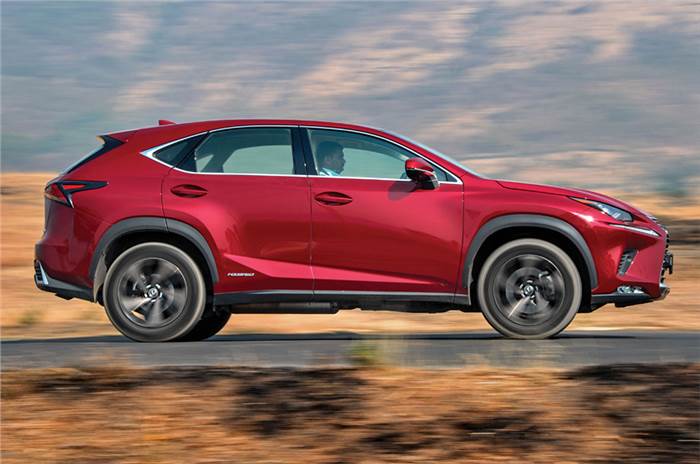
With 235hp from its four-cylinder diesel engine, the XC60 is the most powerful of the lot. It’s also smoother than the Audi’s and even when spun hard, doesn't sound too bad. Power delivery is also super smooth and the Volvo gets an electric air compressor that feeds the engine with air each time you put your foot down, so throttle responses are good and lag is minimal. That said, the mid-range of the engine is a bit lethargic and it doesn't feel like it is 45hp up on the Audi. Its eight-speed automatic unit shifts gears a lot more seamlessly compared to the Q5. But while it performs well at most times like many Audis, it is slow to shift while you're in a hurry.

The Audi accelerates the fastest to 100kph from standstill, in just 7.74sec, while the much more powerful XC60 does the same in 8.36sec and the Lexus NX300h completes the sprint in 9.31sec. In-gear acceleration timings of the XC60 and the Audi are near identical. However, when it comes to panic braking from 80kph, the XC60 sheds speed in the shortest distance of 25.49m, while the NX300h does the same in a 25.64m distance, followed by the Q5 at 26.81m.
| Powertrain & performance | |||
|---|---|---|---|
| Audi Q5 35TDI Technology | Lexus NX300h Luxury | Volvo XC60 Inscription | |
| Engine | 1968cc, 4cyls | 2494cc, 4cyls | 1969cc, 4 cyls |
| Power | 190hp at 3800-4200rpm | 197hp (combined) at 5700rpm | 235hp at 4000rpm |
| Torque | 400Nm at 1750-3000rpm | 210Nm at 4200-4400rpm | 480Nm at 1750-2250rpm |
| Transmission | 7-speed automatic | CVT | 8-speed automatic |
| 0-100kph | 7.74s | 9.31s | 8.36s |
| Top speed | 218kph | 180kph | 230kph |
| 50-80kph | 2.88s | 3.25s | 2.85s |
| 20-80kph | 5.14s | 6.29s | 5.11s |
| 40-100kph | 6.60s | 7.36s | 6.41s |
| 80-0kph braking | 26.81m | 25.64m | 25.49m |
| Fuel efficiency (ARAI) | 17.01kpl | 18.32kpl | 18.8kpl |
How do they compare on ride and handling?
All three SUVs get variable suspension settings that adjust the dampers for either ride comfort or sportier handling. The Audi’s ride is very good, rounding off most bumps on the road, with only muted thuds filtering in the cabin. Body movements, too, are well-controlled and it is also the tauter and more agile of the lot. Its steering is the lightest, however, it lacks a bit of weight and feel, and is also very direct. The Lexus thuds, thumps and pitches over even regular bumps, and body roll is more in corners too. The steering is also poorly calibrated. Its brakes have a regenerative function that recharges the battery using the energy generated while braking, and partly because of this the pedal has almost no feel; which can give you a scare. With air suspension at all four wheels, the XC60 offers the best ride over bad roads, but its low-speed ride is a bit thumpy and hard-edged. However, the XC60 automatically lowers itself to reduce centre of gravity to minimise body roll. The steering is slick and oily smooth and easily the best here. Yet, the Volvo feels dull, lacklustre and devoid of the sharpness and agility of the Audi. This stogy behaviour is made worse as the engine is often slow to respond. And though it has a Dynamic mode, it doesn't appear to make much of a difference.
How much do they cost?
Audi has launched the Q5 in two variants – Premium Plus and Technology (as tested) – priced at Rs 53.25 and Rs 57.60 lakh (ex-showroom, India), respectively. While standard warranty is for two years, it can be extended up to five years, with no restriction on the mileage. Also, because of Audi’s widespread network in India, finding a sales or service outlet will be comparatively easier, and the brand’s recognition will play an important role at the time of selling the car. Hence, it’ll fetch a higher resale value than the others.
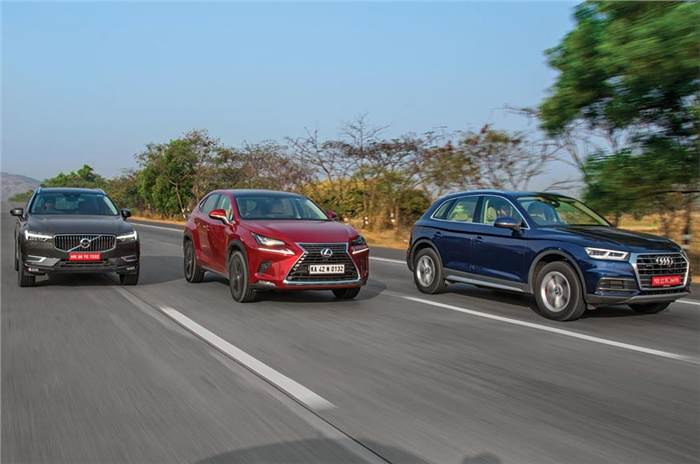
The Lexus NX300h is also available in two variants – Luxury (as tested) and F-Sport, priced at Rs 53.18 and Rs 55.58 lakh (ex-showroom, India), respectively. Lexus offers the best standard warranty of three years or 1,00,000km and an additional two years or 50,000km warranty on the hybrid battery pack. As of date, the company has support available in only eight cities.
Volvo is selling the XC60 in only the Inscription variant that’s priced at Rs 55.90 lakh (ex-showroom, India). Standard warranty on the car is two years, but it can be extended up to the fourth year, with no restriction on kilometres, for just Rs 1.81 lakh.
Which one should you buy?
The Lexus NX300h is for someone who wants a posh, urban hybrid SUV that has a clean footprint. What sweetens the deal is its fuel economy, which is almost as good as the diesel Volvo XC60. And then there's the aggressive price tag. Ride and handling, however, is poor – the engine is unrefined and noisy, the interior quality is not up to class standards in many places, and this SUV has very little driver appeal.
Audi’s new Q5 is beautifully crafted. Its beige cabin feels luxurious and airy, the interiors are well specified, the back seat is the most comfortable of the lot and it rides better than any of the competition here. Then, the engine has plenty of zest, it’s energetic and agile to drive and though the steering feels a bit numb, it’s still the best car here for keen drivers. However, it is a bit bland and lacking in sparkle.
With an equipment list that includes several segment-firsts – like air suspension, Nappa leather, massage seats, and more – the Volvo XC60 just blows the competition away when it comes to sheer opulence. Its diesel engine is smooth and refined, the overall driving experience is very good and it has loads more safety kit than the other cars in its class. Yes, the XC60’s rear seat isn't too comfortable or spacious, it isn’t as agile as the Audi, and the Volvo dealer network is spread thin. Yet, the Volvo is so richly appointed and specified, it just feels like a car from a class above; clearly the best luxury car here. And that’s why it wins.
But perhaps it’s best to hold your SUV buying decision for a bit longer. BMW will launch its new X3 soon and it could just change the pecking order once again.
Copyright (c) Autocar India. All rights reserved.



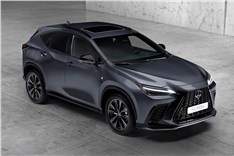



.jpg&w=234&h=156&q=90&c=1)

Comments
Member Login
Personal Details
No comments yet. Be the first to comment.